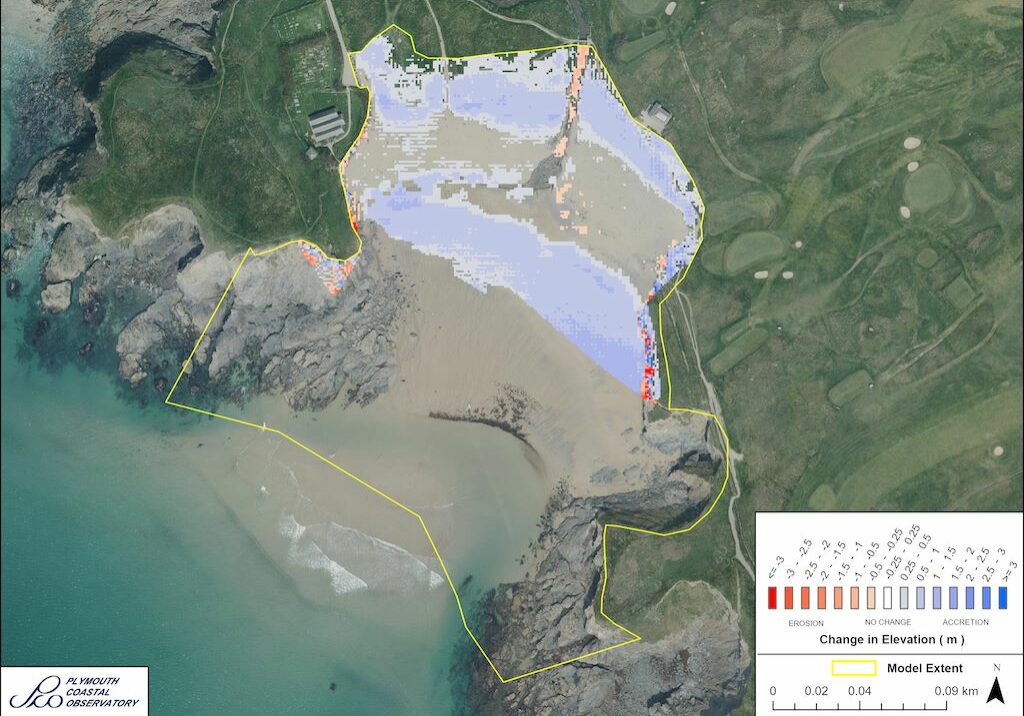
Church Cove (Cornish: Porth Lynnji or Perran Vose, meaning ‘cove of the wall’) is a small south-west facing beach, on the western side of the Lizard Peninsula. Church Cove is named after the small church (St Winwaloe’s Church) which is sheltered by the headland to the west of the beach. The church was originally known as the ‘Church of Storms’, testament to the harsh conditions it has survived. The cove is located at the mouth of the Gunwalloe Stream, which flows across the beach, after meandering through a relatedly broad bottomed and undeveloped valley.
The coarse sand associated with the gently shelving and shallow embayed cove, form sand dunes on the uppershore. In combination with the wetland along the edges of the Gunwalloe Stream, the site is one that provides a rich tapestry of habitats. The location is considered a rural beach that has remained relatively unchanged and undeveloped, with the exception of the Towans that sit behind the site, which have been developed as a golf course.


Coastal Change
The coastline of Cornwall is an ever-changing environment. It is energetic, dynamic, never still and changes with each wave and each tidal cycle. Some of the changes we see are gradual and barely noticeable, whilst others, such as rockfalls, happen suddenly and often shockingly.
From one visit to the next it can sometimes be difficult to see how a beach and dune system has changed, but information has been collected, and is being collected through the Making Space for Sand project, to help us better understand how the coastline is changing. The purpose of this section of the website is to understand each location has changed over time, how it could change in the future and understand the policies that influence how we can respond to these changes.
Shoreline Management Plans (SMP)
The Shoreline Management Plan (SMP) is a strategic planning and management assessment tool that helps identify and measure the risk associated coastal erosion and coastal flooding. The document makes a number of policy recommendations over short, medium and long term timeframes setting out a strategic approach to managing the built, natural and historic environments associated with the coastline. Within SMP there are four policy approaches which have been assigned to stretches of coastlines. The four policies are: No Active Intervention (NAI), Hold the Line (HTL), Managed realignment (MR), and Advance the line (ATL).
Church Cove sits within Policy Development Zone 6 (PDZ6), in Management Area 16 (MA16), within Policy Unit (PU) 16.4. The policy recommendation for this policy unit are detailed in the table below and the SMP can be accessed through the Cornwall Council website
Use your touchscreen
to scroll the below table
| Policy Unit | Policy Plan | ||||
| 2025 | 2055 | 2105 | Comment | ||
| 16.3 | Poldhu Cove
Main Policy Sub Policy
|
NAI LAO |
NAI LAO |
NAI LAO |
Low risk to infrastructure and roads at rear of beach. Allow natural coastal evolution to occur to support conservation interest of protected sites. |
| 16.4 | Church Cove
Main Policy Sub Policy
|
NAI DnD |
NAI DnD |
NAI DnD |
Significant erosion may occur at the rear of Church Cove. This may impact on the Church within epoch 3. Allow natural coastal evolution to occur to support conservation interest of protected sites. However, the area is now a 'Making Space for Sand' site, and some local activity may now be occurring, and approaches may require review.
|
| 16.5 | Jangye-ryn
Main Policy Sub Policy
|
MR SE |
MR SE |
NAI DnD |
Up to 50m of erosion may occur by 2105, resulting in loss of the National Trust owned Winnianton Farm. Manage erosion rates to enable small amount of infrastructure to be realigned, with potential need to realign the road in the short term. This aligns with the National Trust 'Shifting Shores' approach, allowing natural evolution to occur where possible to improve the quality of the coastal environment. Vehicular access likely to be replaced with pedestrian only access.
|
| Key Main Policy: HTL - Hold the Line, A - Advance the Line, NAI – No Active Intervention MR – Managed Realignment
Sub Policy: LAO – Local Activity Only, DnD – Do not Defend, SE – Slow Erosion
|
|||||


National Coastal Erosion Risk Mapping (NCERM)
National Coastal Erosion Risk Mapping (NCERM) provides a baseline of coastal erosion, for the coastline of England, over short, medium and long-term timeframes. The data is based on the natural and defence characteristics of the coastline and provides rates of erosion at differing levels of confidence to help better plan for worse case scenarios. The data provided is for guidance and does not estimate the absolute location of the future coastline.
The basic NCERM lines show erosion estimates for the Short Term (ST-20 years), Medium Term (MT-50 years) and Long Term (LT- 100 years). The data is further categorised by probability: 05 is 5% probability (a 1 in 20 chance of being exceeded) Red Shading, 50 is 50% probability of being exceeded (a 1 in 2 chance of being either exceeded or not exceeded) Orange Shading and 95 is 95% probability (a 19 in 20 chance of being exceeded) Yellow Shading. Click the link below to access the Cornwall Council NCERM Mapping site read the about section then click on layers.

Historical Images
Historical photographs provide a powerful insight into how the Cornish coastline has changed within the past Century. The Making Space for Sand project are working in collaboration with the Francis Frith collection and have been given permission to share historical images on a number of beaches considered within the project.
In looking back, we can better understand how the coastline has changed, helping us understand not only how the coastal fringe has developed but also the potential future changes that we my observe. When this is considered alongside forecasts of coastal erosion and sea level rise it will help enable us to better adapt to our changing coastline.
Image of The Sands at Church Cove, C1960 (Courtesy of the Francis Frith collection) and also in 2024.

Modelling Coastal Change
Using data that has already been collected, combined with data collected through the Making Space for Sand project, a series of models will be carried out at each location. This will help us better understand how each location may respond to sea level rise and gain a deeper understanding of how coastal sediments move and behave.
The complexity of the modelling, and the data collection that helps inform it, means that modelling outputs will not be the same on all sites. Some locations will be more thoroughly investigated to understand more complex issues and provide data that can be more widely applied to other sites with similar characteristics.
As the project develops this section of the website will expand, sharing new reports and coastal change projections when they are produced.
LiDAR surveys, which are explained on the Data Modelling page, have been carried out by the South West Coastal Monitoring program at this location. The image shared here visualises where sand has eroded (areas shaded in red) and where it has built up (areas shaded in blue), between the LiDAR surveys carried out in 1998 and 2019. The darker the shade of red or blue the greater the amount of sand erosion or accumulation has been observed. The image helps visualise that beaches are areas that change shape over time and will continue to do so as sea levels rise.



Beach and Dune Ecology
Beaches and dunes represent an important transition between the marine environment and the terrestrial environment. This transition creates a range of special habitats and exposes a range of interesting features, which that can result in these spaces being highly designated and protected. The Making Space for Sand project will survey a number of dune systems. These surveys will help highlight how they may be changing, will identify rare species, will map invasive species, help us understand overall dune condition and identify potential constraints to improving their condition.
There are a range of designations that recognise a variety of different features. There are also a number of dunes systems where data has been collected to understand their habitat value. These are explored, on a site-by-site basis, in the section below.

Designations
Special Area of Conservation (SAC)
A Special Area of Conservation (SAC) is an internationally recognised designation with the aim of protecting habitats or species that are of European importance. Land with SACs is considered to be part of a network of high-quality conservation sites, and those considered to be most in need of conservation at a European level.
Image of a cuttlefish (Courtesy of Tony Sutton)
The Lizard SAC and Lizard Point SAC
There are two SAC’s associated with the area, the Lizard SAC that covers on area of approximately 3,083 hectares and the Lizard Point SAC that covers an area of approximately 13,995 hectares.
The Lizard SAC, with its complex geology, is rich in a diversity of cliff vegetation, of particular note are the dry and wet heaths The underlying geology of the area creates calcium deficient and acid rich groundwater bodies and support a unusual range of rare plants.
The Lizard Point SAC is unique in terms of its underlying geology, consisting of rugged inshore and offshore areas of submerged bedrock and boulders, separated by extensive areas of thin, coarse mobile sediment.
Image of a hermit crab (Courtesy of Tony Sutton)
Site of Special Scientific Interest (SSSI)
A Site of Special Scientific Interest or SSSI is a statutory conservation designation notified by Natural England denoting protection for biological and/or geological characteristics. The natural wildlife and geological features of SSSI’s are considered to be irreplaceable parts of the national heritage. These are protected in order to preserve their importance, and to prevent damage and development.
The Baulk Head to Mullion SSSI covers an area of 152.3 hectares. Most of the site lies on Devonian sedimentary rocks of the, but in the south metamorphic rocks of the Lizard district underlie the site. Much of the rock exposure here is of special importance in the study of the relationships between these two distinctive geological regions. A number of rare plants occur in this site. The reedbeds here are the second most extensive in Cornwall and harbour a number of uncommon breeding birds.
Image of a snakelock anemone (Courtesy of Susan Scott)
Designated Cornwall National Landscape Area
From November 2023, all areas previously know as Areas of Outstanding Natural Beauty, or AONBs, were re-named National Landscape and in Cornwall became Cornwall National Landscape. However, the Management Plan still references the term AONB as this was formally adopted by Cornwall Council and cannot be amended until the next plan is produced.
Cornwall National Landscape areas are protected landscapes whose distinctive character and natural beauty are so outstanding that it is in the nation’s interest to safeguard them. As such they have been nationally designated by the same legislation as National Parks and have the same status and level of protection.
The South Coast Western section covers an area of 19,258 hectares, which is 20% of the Cornwall National Landscape. The key characteristics of this coastal landscape is a soft profile. It benefits from the protection offered by the Penwith peninsula against the full force of the Atlantic storms.
Image of boats at Cadgwith Harbour (Courtesy of Sue Rowlands)

Beach Dune Management Plan
Many of the sand dunes and beaches around Cornwall’s coast are experiencing erosion and sediment loss. This is due, in part, to lack of new sediment input to the shoreline system and rising sea levels. This is a pressing concern as these environments provide protection against the risk of coastal flooding, provide important habitats that cannot be easily recreated elsewhere if lost and help support the regions thriving tourism industry. It is therefore vital that the sand dunes and beaches around Cornwall’s coast are managed in a more sustainable way that balances the combined functions of beach-dune system.
The Making Space for Sand project hope to develop a number of Beach Dune Management Plans, to complement those that have already been developed by Cornwall Council. It is anticipated that a BDMP will be developed for this location. The aim of the BDMP’s will be to:
- Identify the best day-to-day management approach in terms of monitoring and intervention for the beach and dune system.
- Provide a longer-term approach to beach and dune management based upon an up-to-date understanding of habitat condition, coastal processes at the site, as well as predictions of future coastal evolution.
If you are interested in providing information and data or want to share you knowledge of changes observed on a site where a beach dune management plan is being considered please make contact with the Making Space for Sand project using the email provided at the bottom of this page or on the Community Engagement page.
Sign up to Making Space for Sand
If you would like to get involved in helping to make dunes more resilient and biodiverse, want to help develop coastal adaptation and emergency plans or just want to know more about what the project is learning about coastal change, please click here:




